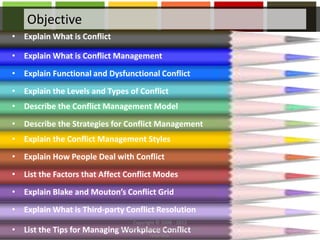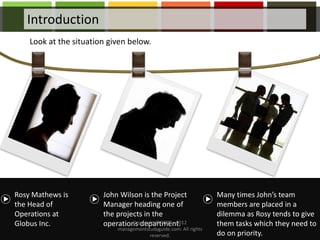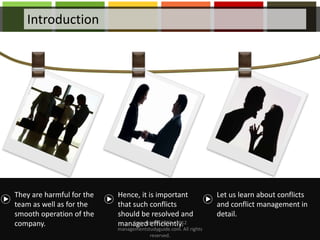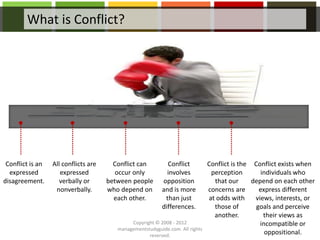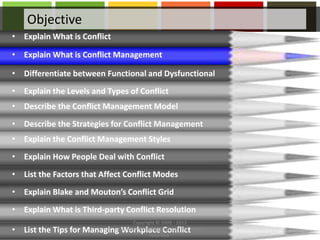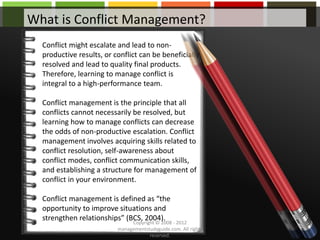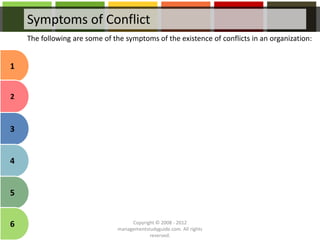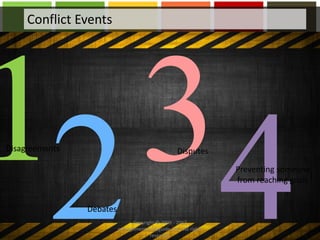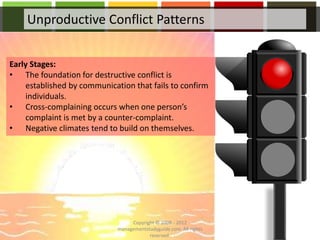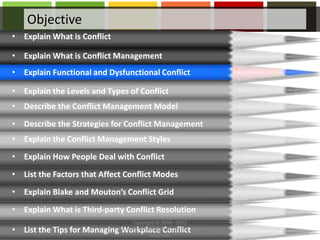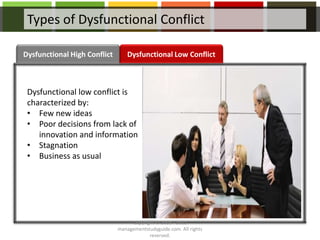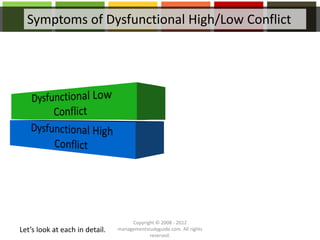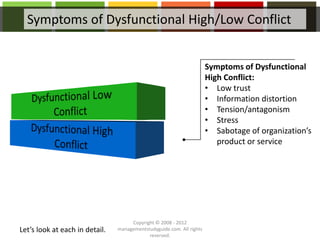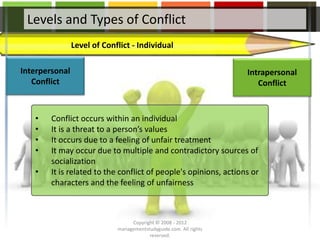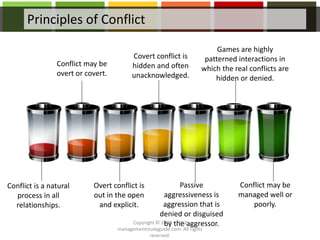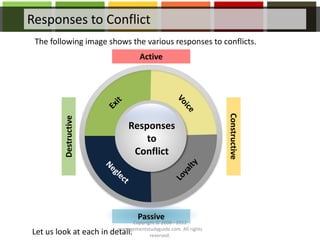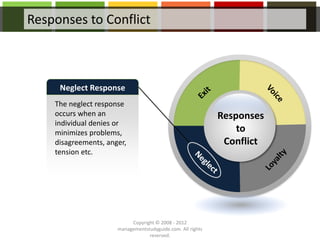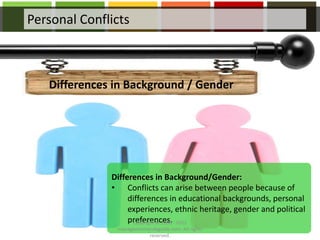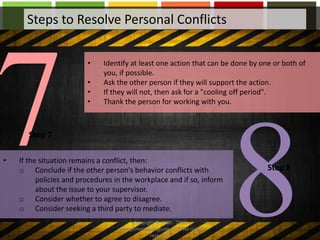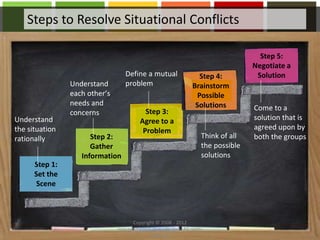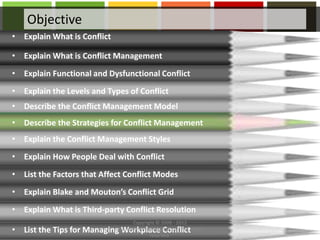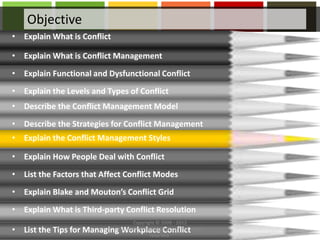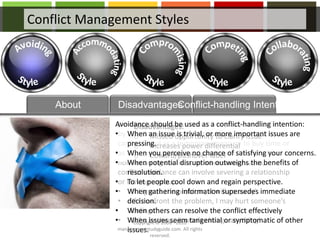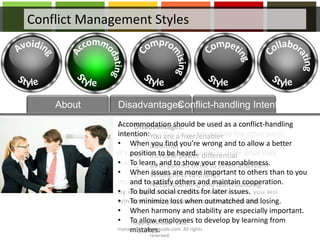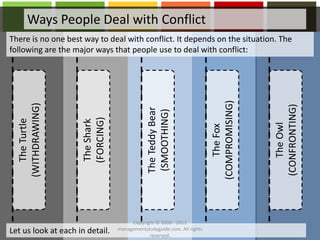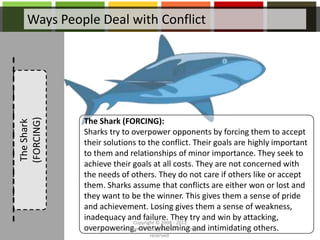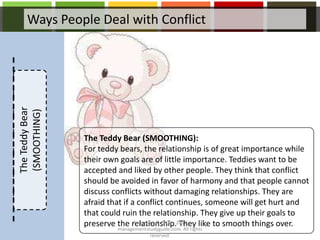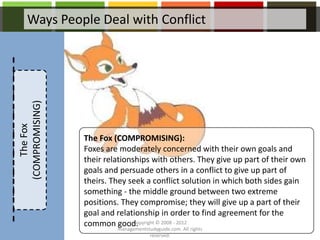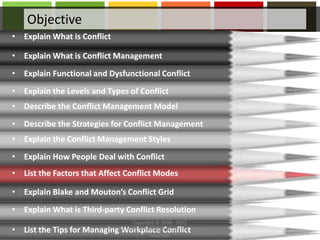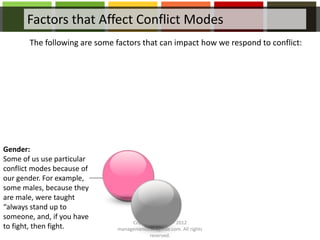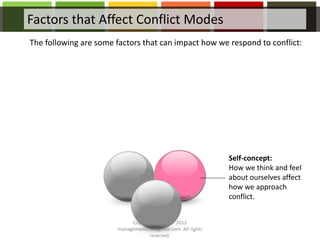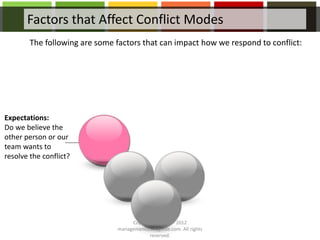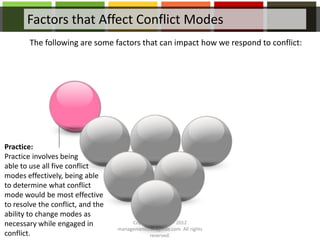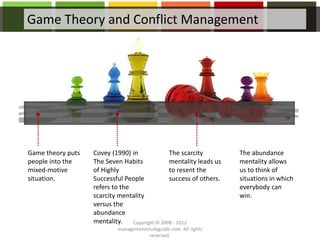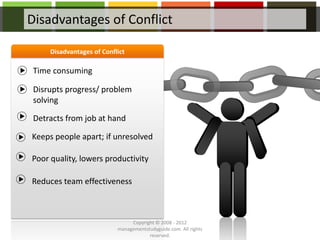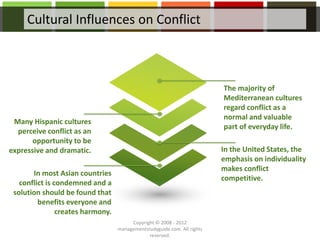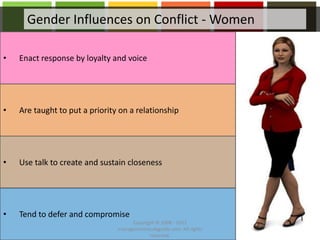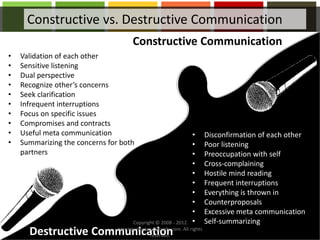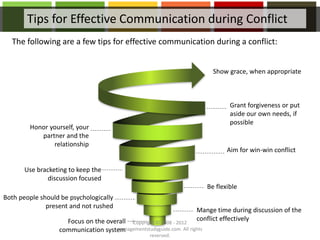Conflict management
- 1. Conflict Management Copyright © 2008 - 2012 managementstudyguide.com. All rights reserved.
- 2. Objective • Explain What is Conflict • Explain What is Conflict Management • Explain Functional and Dysfunctional Conflict • Explain the Levels and Types of Conflict • Describe the Conflict Management Model • Describe the Strategies for Conflict Management • Explain the Conflict Management Styles • Explain How People Deal with Conflict • List the Factors that Affect Conflict Modes • Explain Blake and Mouton’s Conflict Grid • Explain What is Third-party Conflict Resolution • List the Tips for Managing Workplace Conflict Copyright © 2008 - 2012 managementstudyguide.com. All rights reserved.
- 3. Introduction Look at the situation given below. Rosy Mathews is the Head of Operations at Globus Inc. John Wilson is the Project Manager heading one of the projects in the operations department. Many times John’s team members are placed in a dilemma as Rosy tends to give them tasks which they need to do on priority. Copyright © 2008 - 2012 managementstudyguide.com. All rights reserved.
- 4. Introduction Rosy allocates such tasks to John’s team members without consulting or even informing John. Such allocations lead to misunderstanding between John and Rosy. In one or two instances, the situation became so grave that it had led to a heated argument between John and Rosy. Copyright © 2008 - 2012 managementstudyguide.com. All rights reserved.
- 5. Introduction John feels that Rosy unnecessarily interferes in his team’s duties. Rosy feels that John is crossing his limits beyond that of a Project Manager. Such conflicts at the workplace are very harmful. Copyright © 2008 - 2012 managementstudyguide.com. All rights reserved.
- 6. Introduction They are harmful for the team as well as for the smooth operation of the company. Hence, it is important that such conflicts should be resolved and managed efficiently. Let us learn about conflicts and conflict management in detail. Copyright © 2008 - 2012 managementstudyguide.com. All rights reserved.
- 7. Objective • Explain What is Conflict • Explain What is Conflict Management • Explain Functional and Dysfunctional Conflict • Explain the Levels and Types of Conflict • Describe the Conflict Management Model • Describe the Strategies for Conflict Management • Explain the Conflict Management Styles • Explain How People Deal with Conflict • List the Factors that Affect Conflict Modes • Explain Blake and Mouton’s Conflict Grid • Explain What is Third-party Conflict Resolution • List the Tips for Managing Workplace Conflict • Explain What is Conflict Copyright © 2008 - 2012 managementstudyguide.com. All rights reserved.
- 8. What is Conflict? Conflict is an expressed disagreement. • All conflicts are expressed verbally or nonverbally. • Conflict can occur only between people who depend on each other. • Conflict involves opposition and is more than just differences. • Conflict is the perception that our concerns are at odds with those of another. • Conflict exists when individuals who depend on each other express different views, interests, or goals and perceive their views as incompatible or oppositional. • • • • • Copyright © 2008 - 2012 managementstudyguide.com. All rights reserved.
- 9. What is Conflict? It is characterized by the following: Opposition Antagonistic interaction Incompatible behavior Block another party from reaching her or his goals Copyright © 2008 - 2012 managementstudyguide.com. All rights reserved.
- 10. What is Conflict? Conflict is not always bad for an organization. It is not necessary that organizations need to reduce all conflict. Conflicts are an inevitable part of organization life and are needed for growth and survival. Conflict management includes increasing and decreasing conflict. Conflict management is a major responsibility of the management. Copyright © 2008 - 2012 managementstudyguide.com. All rights reserved.
- 11. Definition Conflict is when two or more people have differences in ideas/views and are not ready to understand or accept each other’s ideas/views. Copyright © 2008 - 2012 managementstudyguide.com. All rights reserved.
- 12. Objective • Explain What is Conflict • Explain What is Conflict Management • Differentiate between Functional and Dysfunctional Conflict • Explain the Levels and Types of Conflict • Describe the Conflict Management Model • Describe the Strategies for Conflict Management • Explain the Conflict Management Styles • Explain How People Deal with Conflict • List the Factors that Affect Conflict Modes • Explain Blake and Mouton’s Conflict Grid • Explain What is Third-party Conflict Resolution • List the Tips for Managing Workplace Conflict • Explain What is Conflict Management Copyright © 2008 - 2012 managementstudyguide.com. All rights reserved.
- 13. What is Conflict Management? Conflict might escalate and lead to non- productive results, or conflict can be beneficially resolved and lead to quality final products. Therefore, learning to manage conflict is integral to a high-performance team. Conflict management is the principle that all conflicts cannot necessarily be resolved, but learning how to manage conflicts can decrease the odds of non-productive escalation. Conflict management involves acquiring skills related to conflict resolution, self-awareness about conflict modes, conflict communication skills, and establishing a structure for management of conflict in your environment. Conflict management is defined as “the opportunity to improve situations and strengthen relationships” (BCS, 2004).Copyright © 2008 - 2012 managementstudyguide.com. All rights reserved.
- 14. Causes of Conflict Methodological differences Substandard performance Lack of cooperation Differences regarding authority Differences regarding responsibility Competition over resources Non-compliance with rules (LO) The following are the causes of conflict: Copyright © 2008 - 2012 managementstudyguide.com. All rights reserved.
- 15. Causes of Conflict Ideological differences Opinion differences Behavior differences Fear Dishonesty Boundaries Negligence Need to be right Copyright © 2008 - 2012 managementstudyguide.com. All rights reserved.
- 16. Causes of Conflict Miscommunication Mishandling conflict in the past Hidden agenda Revenge Fighting the “last war” Personality conflict Value differences Goal differences Copyright © 2008 - 2012 managementstudyguide.com. All rights reserved.
- 17. Symptoms of Conflict The following are some of the symptoms of the existence of conflicts in an organization: 1 2 3 4 5 6 Copyright © 2008 - 2012 managementstudyguide.com. All rights reserved.
- 18. Symptoms of Conflict The following are some of the symptoms of the existence of conflicts in an organization: 7 8 9 10 11 12 Copyright © 2008 - 2012 managementstudyguide.com. All rights reserved.
- 19. Conflict Events Debates Disagreements Preventing someone from reaching goals Disputes Copyright © 2008 - 2012 managementstudyguide.com. All rights reserved.
- 20. Unproductive Conflict Patterns There are various stages of unproductive conflict patterns, such as follows: Let’s look at each in detail. Early Stages Middle Stages Later Stages Copyright © 2008 - 2012 managementstudyguide.com. All rights reserved.
- 21. Unproductive Conflict Patterns Early Stages: • The foundation for destructive conflict is established by communication that fails to confirm individuals. • Cross-complaining occurs when one person’s complaint is met by a counter-complaint. • Negative climates tend to build on themselves. Copyright © 2008 - 2012 managementstudyguide.com. All rights reserved.
- 22. Unproductive Conflict Patterns Middle Stages: • Once a negative climate has been set, it is stoked by other unconstructive communication. • Almost everything is thrown into the argument. • Focusing on specific issues resolves conflicts constructively. • Marked by frequent interruptions that disrupt the flow of talk. Copyright © 2008 - 2012 managementstudyguide.com. All rights reserved.
- 23. Unproductive Conflict Patterns Later Stages: • Solutions become the focus. • Each person’s proposals are met with counterproposals. • Excessive Meta communication may occur. • The communication patterns are discussed and never return to the issues. • Communication that makes up unproductive conflict reflects egocentrism, dogmatism and is self perpetuating. • Unproductive conflict doesn’t involve dual perspective and it seals off awareness of common grounds. Copyright © 2008 - 2012 managementstudyguide.com. All rights reserved.
- 24. Objective • Explain What is Conflict • Explain What is Conflict Management • Explain Functional and Dysfunctional Conflict • Explain the Levels and Types of Conflict • Describe the Conflict Management Model • Describe the Strategies for Conflict Management • Explain the Conflict Management Styles • Explain How People Deal with Conflict • List the Factors that Affect Conflict Modes • Explain Blake and Mouton’s Conflict Grid • Explain What is Third-party Conflict Resolution • List the Tips for Managing Workplace Conflict • Explain Functional and Dysfunctional Conflict Copyright © 2008 - 2012 managementstudyguide.com. All rights reserved.
- 25. Functional and Dysfunctional Conflict Let us look at each in detail. Copyright © 2008 - 2012 managementstudyguide.com. All rights reserved.
- 26. Functional and Dysfunctional Conflict • Functional Conflict is also known as ‘Constructive Conflict’ • It helps to work toward the goals of an organization or group • It increases information and ideas • It encourages innovative thinking • It unshackles different points of view • It reduces stagnation Copyright © 2008 - 2012 managementstudyguide.com. All rights reserved.
- 27. Functional and Dysfunctional Conflict • Dysfunctional conflict blocks an organization or group from reaching its goals • There are two levels of dysfunctional conflict: o Dysfunctional High Conflict: what you typically think about conflict o Dysfunctional Low Conflict: an atypical view • These levels may vary among groupsCopyright © 2008 - 2012 managementstudyguide.com. All rights reserved.
- 28. Types of Dysfunctional Conflict Dysfunctional High Conflict Dysfunctional high conflict is characterized by: • Tension, anxiety, stress • Drives out low conflict tolerant people • Reduced trust • Poor decisions because of withheld or distorted information • Excessive management focus on the conflict Copyright © 2008 - 2012 managementstudyguide.com. All rights reserved.
- 29. Dysfunctional High ConflictDysfunctional High Conflict Types of Dysfunctional Conflict Dysfunctional Low Conflict Dysfunctional low conflict is characterized by: • Few new ideas • Poor decisions from lack of innovation and information • Stagnation • Business as usual Copyright © 2008 - 2012 managementstudyguide.com. All rights reserved.
- 30. Symptoms of Dysfunctional High/Low Conflict Let’s look at each in detail. Copyright © 2008 - 2012 managementstudyguide.com. All rights reserved.
- 31. Symptoms of Dysfunctional High/Low Conflict Let’s look at each in detail. Symptoms of Dysfunctional High Conflict: • Low trust • Information distortion • Tension/antagonism • Stress • Sabotage of organization’s product or service Copyright © 2008 - 2012 managementstudyguide.com. All rights reserved.
- 32. Symptoms of Dysfunctional High/Low Conflict Let’s look at each in detail. Symptoms of Dysfunctional Low Conflict: • Deny differences • Repress controversial information • Prohibit disagreements • Avoid interactions • Walk away from conflict episode Copyright © 2008 - 2012 managementstudyguide.com. All rights reserved.
- 33. Objective • Explain What is Conflict • Explain What is Conflict Management • Explain Functional and Dysfunctional Conflict • Explain the Levels and Types of Conflict • Describe the Conflict Management Model • Describe the Strategies for Conflict Management • Explain the Conflict Management Styles • Explain How People Deal with Conflict • List the Factors that Affect Conflict Modes • Explain Blake and Mouton’s Conflict Grid • Explain What is Third-party Conflict Resolution • List the Tips for Managing Workplace Conflict • Explain the Levels and Types of Conflict Copyright © 2008 - 2012 managementstudyguide.com. All rights reserved.
- 34. Levels and Types of Conflict • Type of Conflict • Within and between organizations • Within and between groups • Within and between individuals Level of Conflict Organization Group Individual Let us look at each in detail. Copyright © 2008 - 2012 managementstudyguide.com. All rights reserved.
- 35. Levels and Types of Conflict Level of Conflict - Organization Intra-organization Conflict Inter-organization conflict Let us look at each in detail. Copyright © 2008 - 2012 managementstudyguide.com. All rights reserved.
- 36. Levels and Types of Conflict Level of Conflict - Organization Intra-organization Conflict Inter-organization conflict • Conflict that occurs within an organization • Such a conflict occurs at interfaces of organization functions • It can occur along the vertical and horizontal dimensions of the organization • Vertical conflict: Vertical conflict occurs between managers and subordinates • Horizontal conflict: Horizontal conflict occurs between departments and work groups Copyright © 2008 - 2012 managementstudyguide.com. All rights reserved.
- 37. Levels and Types of Conflict Level of Conflict - Organization Intra-organization Conflict Inter-organization conflict • Conflict occurs between two or more organizations • The conflict is not similar to competition • For example: Conflict between suppliers and distributors, especially with the close links now possible Copyright © 2008 - 2012 managementstudyguide.com. All rights reserved.
- 38. Levels and Types of Conflict Level of Conflict - Group Intra-group Conflict Inter-group Conflict Let us look at each in detail. Copyright © 2008 - 2012 managementstudyguide.com. All rights reserved.
- 39. Levels and Types of Conflict Level of Conflict - Group Intra-group Conflict Inter-group Conflict • Conflict among members of a group • It usually occurs in early stages of group development • It may occur due to different ways of doing tasks or reaching group's goals Copyright © 2008 - 2012 managementstudyguide.com. All rights reserved.
- 40. Levels and Types of Conflict Level of Conflict - Group Intra-group Conflict Inter-group Conflict • Conflict occurs between two or more groups • It may occur due to different ways of doing tasks or reaching group's goals Copyright © 2008 - 2012 managementstudyguide.com. All rights reserved.
- 41. Levels and Types of Conflict Level of Conflict - Individual Interpersonal Conflict Intrapersonal Conflict Let us look at each in detail. Copyright © 2008 - 2012 managementstudyguide.com. All rights reserved.
- 42. Levels and Types of Conflict Level of Conflict - Individual Interpersonal Conflict Intrapersonal Conflict • Conflict occurs between two or more people • It occurs due to differences in views about what should be done • It requires more efforts and more resources to get a task done due to the conflict • Differences in orientation to work and time in different parts of an organization Copyright © 2008 - 2012 managementstudyguide.com. All rights reserved.
- 43. Levels and Types of Conflict Level of Conflict - Individual Interpersonal Conflict Intrapersonal Conflict • Conflict occurs within an individual • It is a threat to a person’s values • It occurs due to a feeling of unfair treatment • It may occur due to multiple and contradictory sources of socialization • It is related to the conflict of people's opinions, actions or characters and the feeling of unfairness Copyright © 2008 - 2012 managementstudyguide.com. All rights reserved.
- 44. Conflict Episodes Conflict episodes are the ebb and flow of conflict. Latent Conflict Perceived Conflict Felt Conflict Manifest Conflict Conflict Aftermath Conflict Reduction Let us look at each part of a conflict episode in detail. Copyright © 2008 - 2012 managementstudyguide.com. All rights reserved.
- 45. Conflict Episodes Latent Conflict Perceived Conflict Felt Conflict Manifest Conflict Conflict Aftermath Conflict Reduction Latent Conflict Latent Conflict: • Latent conflict is the antecedents of conflict behavior that can start a conflict episode. • Some of the latent conflict in the lives of employees may be: o Parking spaces o Copying machines o Office and other parts of their life o Company policies Copyright © 2008 - 2012 managementstudyguide.com. All rights reserved.
- 46. Conflict Episodes Latent Conflict Perceived Conflict Felt Conflict Manifest Conflict Conflict Aftermath Conflict Reduction Perceived Conflict Perceived Conflict: • Perceived conflict is about becoming aware that one is in conflict with another party • It can block out some conflict • A person can perceive conflict when no latent conditions exist • Example: misunderstanding another person’s position on an issue Copyright © 2008 - 2012 managementstudyguide.com. All rights reserved.
- 47. Conflict Episodes Latent Conflict Perceived Conflict Felt Conflict Manifest Conflict Conflict Aftermath Conflict Reduction Felt Conflict Felt Conflict: • This is the emotional part of conflict • It includes the personalizing of a conflict by a person • It includes oral and physical hostility • It is hard to manage episodes with high felt conflict • This is what people are likely to recall about a conflict Copyright © 2008 - 2012 managementstudyguide.com. All rights reserved.
- 48. Conflict Episodes Latent Conflict Perceived Conflict Felt Conflict Manifest Conflict Conflict Aftermath Conflict Reduction Manifest Conflict Manifest Conflict: • This is the observable conflict behavior. • Some examples of conflict behavior include disagreements, discussions etc. Copyright © 2008 - 2012 managementstudyguide.com. All rights reserved.
- 49. Conflict Episodes Latent Conflict Perceived Conflict Felt Conflict Manifest Conflict Conflict Aftermath Conflict Reduction Conflict Aftermath Conflict Aftermath: • This is the end of a conflict episode. • It may often be the starting point of a related episode. • It becomes the latent conflict for another episode. Copyright © 2008 - 2012 managementstudyguide.com. All rights reserved.
- 50. Conflict Episodes Latent Conflict Perceived Conflict Felt Conflict Manifest Conflict Conflict Aftermath Conflict Reduction Conflict Reduction Conflict Reduction: • This is the lowering of the conflict level. Copyright © 2008 - 2012 managementstudyguide.com. All rights reserved.
- 51. Relationships among Conflict Episodes Latent Conflict Manifest Conflict Conflict Aftermath Conflict Reduction Latent Conflict Manifest Conflict Conflict Aftermath Latent Conflict Manifest Conflict Conflict Aftermath The given image shows the relationship between conflict episodes. Episodes link through the connection of conflict aftermath to latent conflict. Effective conflict management involves breaking this connection. Hence, for effective conflict management, it is crucial to discover the latent conflicts and remove them. Copyright © 2008 - 2012 managementstudyguide.com. All rights reserved.
- 52. Latent Conflict in Organizations Latent Conflict is the antecedents to conflict episodes. Many natural conditions of organizations act as latent conflicts. Latent Conflicts lurk in the background and then they trigger conflict when the right conditions occur. A Latent Conflict does not always lead to manifest conflict. Latent Conflicts give us clues about how to reduce dysfunctional high conflict. Copyright © 2008 - 2012 managementstudyguide.com. All rights reserved.
- 53. Sources of Latent Conflict in Organizations Some sources of latent conflict in organizations are as follows: Scarce resources: Such as money, equipment, facilities etc. Organizational differentiation: Different orientations in different parts of organization Rules, procedures, policies: Behavioral guides that can cause clashes Cohesive groups: Value & orientation differences among groupsCopyright © 2008 - 2012 managementstudyguide.com. All rights reserved.
- 54. Sources of Latent Conflict in Organizations Some sources of latent conflict in organizations are as follows: Interdependence: Interdependence forces interaction among people Communication barriers: Shift work and jargon may lead to confusion and unclear communication Ambiguous jurisdictions: Areas of authority not clearly defined may lead to conflicts Reward systems: Rewarding of different behavior in different parts of the organization may lead to conflicts Copyright © 2008 - 2012 managementstudyguide.com. All rights reserved.
- 55. Conflict Orientations There are various kinds of orientation or direction that can be given to the conflicts arising in an organization such as: • Dominance: wants to win; conflict is a battle • Collaborative: wants to find a solution that satisfies everyone • Compromise: splits the differences • Avoidance: backs away • Accommodative: focuses on desires of other party Dominance Collaborative Compromise Avoidance Accommodative Copyright © 2008 - 2012 managementstudyguide.com. All rights reserved.
- 56. Conflict Orientations It also depends upon the perception of opponent's power Copyright © 2008 - 2012 managementstudyguide.com. All rights reserved.
- 57. Conflict Orientations There may be different combinations of conflict orientations in a group, such as follows: Dominance, avoidance Dominance, dominance Avoidance, avoidance Dominance, collaborative, compromise Collaborative, compromise, avoidance Collaborative, compromise, avoidance, dominance, accommodativeCopyright © 2008 - 2012 managementstudyguide.com. All rights reserved.
- 58. Principles of Conflict Conflict is a natural process in all relationships. Conflict may be overt or covert. Overt conflict is out in the open and explicit. Covert conflict is hidden and often unacknowledged. Passive aggressiveness is aggression that is denied or disguised by the aggressor. Games are highly patterned interactions in which the real conflicts are hidden or denied. Conflict may be managed well or poorly. Copyright © 2008 - 2012 managementstudyguide.com. All rights reserved.
- 59. Principles of Conflict It allows us to consider other points of views. Conflict may be good for individuals and relationships. It can support our own identity by clarifying how we differ from others. It expands partners’ views of each other. It involves intense emotions that we may not know how to handle. It can either promote continuing attachment or split a relationship apart, depending on how differences are managed. Learning communication skills can help us deal with differences. Copyright © 2008 - 2012 managementstudyguide.com. All rights reserved.
- 60. Approaches to Conflict One party gets satisfaction The other party gets satisfaction Neither party gets satisfaction Both parties feel satisfied Win / Lose Lose / Win Lose / Lose Win / Win Copyright © 2008 - 2012 managementstudyguide.com. All rights reserved.
- 61. Responses to Conflict The following image shows the various responses to conflicts. Let us look at each in detail. Responses to Conflict Active Passive Destructive Constructive Copyright © 2008 - 2012 managementstudyguide.com. All rights reserved.
- 62. Responses to Conflict Responses to Conflict The exit response involves leaving a relationship either by physically walking out or by psychologically withdrawing. Exit Response Copyright © 2008 - 2012 managementstudyguide.com. All rights reserved.
- 63. Responses to Conflict Responses to Conflict The neglect response occurs when an individual denies or minimizes problems, disagreements, anger, tension etc. Neglect Response Copyright © 2008 - 2012 managementstudyguide.com. All rights reserved.
- 64. Responses to Conflict Responses to Conflict The loyalty response is staying committed to a relationship despite differences. Loyalty Response Copyright © 2008 - 2012 managementstudyguide.com. All rights reserved.
- 65. Responses to Conflict Responses to Conflict The voice response is an active, constructive strategy for dealing with conflict by talking about problems and trying to resolve them. Voice Response Copyright © 2008 - 2012 managementstudyguide.com. All rights reserved.
- 66. Types of Conflict There are various kinds of conflicts such as follows: • Differences in Style • Differences in Background/Gender • Differences in Personality • Interdependence Conflicts • Differences in Leadership Let us look at each in detail. Copyright © 2008 - 2012 managementstudyguide.com. All rights reserved.
- 67. Personal Conflicts Personal conflicts are related to your or others behavior/style. Differences in Personality Differences in Background / Gender Differences in Style Let us look at each in detail. Copyright © 2008 - 2012 managementstudyguide.com. All rights reserved.
- 68. Personal Conflicts Differences in Style Differences in Style: • These conflicts occur because people's style for a completing job can differ. • For example: One person may just want to get the work done quickly (task oriented), while another is more concerned about having it done in a particular way e.g. artistic Copyright © 2008 - 2012 managementstudyguide.com. All rights reserved.
- 69. Personal Conflicts Differences in Background / Gender Differences in Background/Gender: • Conflicts can arise between people because of differences in educational backgrounds, personal experiences, ethnic heritage, gender and political preferences.Copyright © 2008 - 2012 managementstudyguide.com. All rights reserved.
- 70. Personal Conflicts Differences in Personality Differences in Personality: • This type of conflict is often fueled by emotion and perceptions about somebody else's motives and character. • For example: A team leader shouts on someone for being late because he perceives the team member as being lazy and inconsiderate. The team member sees the team leader as being irrational.Copyright © 2008 - 2012 managementstudyguide.com. All rights reserved.
- 71. Situational Conflicts Situational conflicts are based on the situation you are in. Differences in Leadership Interdependence Conflicts Let us look at each in detail. Copyright © 2008 - 2012 managementstudyguide.com. All rights reserved.
- 72. Situational Conflicts Interdependence Conflicts Interdependence Conflicts: • Such conflicts occur when a person's job depends on someone else's co-operation, output or input. • For example: A sales-person who is constantly late in submitting the monthly sales figures may cause the accountant to be late in submitting her reports.Copyright © 2008 - 2012 managementstudyguide.com. All rights reserved.
- 73. Situational Conflicts Differences in Leadership Differences in Leadership: • Leaders have different styles. Conflicts may occur when employees who move from under one supervisor to another become confused. • For example: One leader may be more open and delegates responsibility whilst another may be more directive. For an employee it becomes a conflict situation when he has to change his leader.Copyright © 2008 - 2012 managementstudyguide.com. All rights reserved.
- 74. Steps to Resolve Personal Conflicts Step 1 • Manage yourself. If you and/or the other person are getting angry, then manage yourself to stay calm by: o Speaking to the person as if the other person is not angry o Avoid the use of the word "you" - this avoids blaming. o Nod your head to assure the other person that you heard him. o Maintain eye contact with him. Step 2 • Move the discussion to a private area, if possible. Copyright © 2008 - 2012 managementstudyguide.com. All rights reserved.
- 75. Steps to Resolve Personal Conflicts Step 3 • Give the other person some time to vent his emotions. Don't interrupt them or judge what they are saying. • Check with the other person and verify that you're hearing each other accurately. When the other person stops speaking, then: o Ask the other person to let you rephrase what you heard from the other person and what you understood about his point of view. o Ask open-ended questions to understand him more. o Avoid "why" questions – those questions often make people feel defensive. Step 4 Copyright © 2008 - 2012 managementstudyguide.com. All rights reserved.
- 76. Steps to Resolve Personal Conflicts Step 5 • Repeat the step 4, this time ask the other person to verify what they heard from you and understood. When you present your position o Use "I", not "you". o Talk in terms of the present as much as possible. o Mention your feelings. Step 6 • Acknowledge where you disagree and where you agree. Work on the issue, not the person. o When they are convinced that you understand them: Ask "What can we do fix the problem?" There is a high possibility that they will begin to complain again. o Then ask the same question. Focus on actions they can do, too. Copyright © 2008 - 2012 managementstudyguide.com. All rights reserved.
- 77. Steps to Resolve Personal Conflicts Step 7 • Identify at least one action that can be done by one or both of you, if possible. • Ask the other person if they will support the action. • If they will not, then ask for a "cooling off period". • Thank the person for working with you. • If the situation remains a conflict, then: o Conclude if the other person's behavior conflicts with policies and procedures in the workplace and if so, inform about the issue to your supervisor. o Consider whether to agree to disagree. o Consider seeking a third party to mediate. Step 8 Copyright © 2008 - 2012 managementstudyguide.com. All rights reserved.
- 78. Steps to Resolve Situational Conflicts Step 1: Set the Scene Step 2: Gather Information Step 3: Agree to a Problem Step 4: Brainstorm Possible Solutions Step 5: Negotiate a Solution Let’s look at each in detail. Copyright © 2008 - 2012 managementstudyguide.com. All rights reserved.
- 79. Steps to Resolve Situational Conflicts Step 1: Set the Scene Step 2: Gather Information Step 3: Agree to a Problem Step 4: Brainstorm Possible Solutions Step 5: Negotiate a Solution Understand the situation rationally Understand each other’s needs and concerns Define a mutual problem Think of all the possible solutions Come to a solution that is agreed upon by both the groups Copyright © 2008 - 2012 managementstudyguide.com. All rights reserved.
- 80. Objective • Explain What is Conflict • Explain What is Conflict Management • Explain Functional and Dysfunctional Conflict • Explain the Levels and Types of Conflict • Describe the Conflict Management Model • Describe the Strategies for Conflict Management • Explain the Conflict Management Styles • Explain How People Deal with Conflict • List the Factors that Affect Conflict Modes • Explain Blake and Mouton’s Conflict Grid • Explain What is Third-party Conflict Resolution • List the Tips for Managing Workplace Conflict • Describe the Conflict Management Model Copyright © 2008 - 2012 managementstudyguide.com. All rights reserved.
- 81. Conflict Management Model Organizational Culture Product or Service Fast-changing Environment Perceived Conflict Requirements Desired Conflict Level A conflict management model can be used by an organization to reach the desired conflict levels in an organization. Copyright © 2008 - 2012 managementstudyguide.com. All rights reserved.
- 82. Conflict Management Model The Conflict Management Model is used to: 1 Maintain conflict at functional levels 2 Not completely eliminate conflicts 3 Reduce conflicts to functional levels 4 Increase dysfunctional low conflict 5 Choose desired level of conflict based on perceived conflict requirements 6 Vary conflict in different parts of an organization 7 Handle manager’s tolerance for conflict as it plays a crucial role in conflict management Copyright © 2008 - 2012 managementstudyguide.com. All rights reserved.
- 83. Conflict Management Process The process of conflict consists of five stages as shown in the given image. Copyright © 2008 - 2012 managementstudyguide.com. All rights reserved.
- 84. Objective • Explain What is Conflict • Explain What is Conflict Management • Explain Functional and Dysfunctional Conflict • Explain the Levels and Types of Conflict • Describe the Conflict Management Model • Describe the Strategies for Conflict Management • Explain the Conflict Management Styles • Explain How People Deal with Conflict • List the Factors that Affect Conflict Modes • Explain Blake and Mouton’s Conflict Grid • Explain What is Third-party Conflict Resolution • List the Tips for Managing Workplace Conflict • Describe the Strategies for Conflict Management Copyright © 2008 - 2012 managementstudyguide.com. All rights reserved.
- 85. Strategies for Conflict Management Larson and Gray provided five strategies for managing dysfunctional conflict. These strategies are: Let’s look at each in detail. Arbitration Control Acceptance Mediation Elimination Copyright © 2008 - 2012 managementstudyguide.com. All rights reserved.
- 86. Strategies for Conflict Management Mediation: The goal is to identify multiple possible alternatives and to mutually select one that is acceptable to all involved parties and in the interest of project objectives. Arbitration Control Acceptance Elimination MediationMediation Copyright © 2008 - 2012 managementstudyguide.com. All rights reserved.
- 87. Strategies for Conflict Management Arbitration: This strategy requires the project manager to provide a safe and productive opportunity for the conflicted parties to air their disagreements. After careful attention and fully listening to each party, the project manager should formulate, define, and provide a solution to the parties. This strategy is based on the forcing approach to conflict. Arbitration can often be effectively combined with mediation by forcing an initial conflict solution and then allowing the parties to negotiate to a more mutually acceptable alternative. Arbitration Control Acceptance Elimination Mediation Arbitration Copyright © 2008 - 2012 managementstudyguide.com. All rights reserved.
- 88. Strategies for Conflict Management Control: Based on the smoothing approach, this strategy seeks to bring tension and emotions down to a level at which productive discussion and negotiation can occur. Humor is often an effective tool, as well as the use of temporary breaks or time-outs in the discussions between conflicted parties. Arbitration Control Acceptance Elimination Mediation Control Copyright © 2008 - 2012 managementstudyguide.com. All rights reserved.
- 89. Strategies for Conflict Management Acceptance: An acceptance decision can be made that the conflict consequences are negligible relative to project objectives and, therefore, require no action. This strategy carries significant risk of later escalation and should be combined with specific plans for monitoring the situation to ensure that the conflict remains at an acceptable level. Arbitration Control Acceptance Elimination Mediation Acceptance Copyright © 2008 - 2012 managementstudyguide.com. All rights reserved.
- 90. Strategies for Conflict Management Elimination: The elimination strategy is reserved for those conflicts that have become so dysfunctional that the project can no longer tolerate any impacts from them. Often a last resort, elimination involves the removal of the conflicted parties from involvement with the project. Arbitration Control Acceptance Elimination Mediation Elimination Copyright © 2008 - 2012 managementstudyguide.com. All rights reserved.
- 91. Objective • Explain What is Conflict • Explain What is Conflict Management • Explain Functional and Dysfunctional Conflict • Explain the Levels and Types of Conflict • Describe the Conflict Management Model • Describe the Strategies for Conflict Management • Explain the Conflict Management Styles • Explain How People Deal with Conflict • List the Factors that Affect Conflict Modes • Explain Blake and Mouton’s Conflict Grid • Explain What is Third-party Conflict Resolution • List the Tips for Managing Workplace Conflict • Explain the Conflict Management Styles Copyright © 2008 - 2012 managementstudyguide.com. All rights reserved.
- 92. Conflict Management Styles Thomas & Kilman conflict management styles can be used to assess one's dominant style for addressing conflict. Not only is it important to know what relationship or situation is causing conflict, but it is also important to look at how we normally resolve conflict (our natural inclination). We must then decide whether we are satisfied with our current approach or if we would like to change it in some way to improve our effectiveness at conflict resolution.Copyright © 2008 - 2012 managementstudyguide.com. All rights reserved.
- 93. Conflict Management Styles There are five conflict management styles identified by Thomas & Kilman in 1976, as per the natural inclinations of people. They are: Let us look at each in detail. Copyright © 2008 - 2012 managementstudyguide.com. All rights reserved.
- 94. Conflict Management Styles About Avoiding style means to avoid or postpone conflict by ignoring it, changing the subject, etc. Avoidance can be useful as a temporary measure to buy time or as an expedient means of dealing with very minor, non-recurring conflicts. In more severe cases, conflict avoidance can involve severing a relationship or leaving a group. • ‘If I ignore the problem, it will go away’ • ‘If I confront the problem, I may hurt someone’s feelings’ • ‘Why bother… it won’t change anything’ Disadvantages • Disadvantages: o Missed opportunity to clarify issue o Increases power differential o Coward/pushover label Conflict-handling Intention Avoidance should be used as a conflict-handling intention: • When an issue is trivial, or more important issues are pressing. • When you perceive no chance of satisfying your concerns. • When potential disruption outweighs the benefits of resolution. • To let people cool down and regain perspective. • When gathering information supersedes immediate decision. • When others can resolve the conflict effectively • When issues seem tangential or symptomatic of other issues. Copyright © 2008 - 2012 managementstudyguide.com. All rights reserved.
- 95. Conflict Management Styles About Accommodation style means to surrender one's own needs and wishes to accommodate the other party. It’s easier to just give in and give them what they want You will be better liked if you just agree By letting the other person win this time, you will win next time; you have to pick your battles. Disadvantages • Disadvantages: o You are a fixer/enabler o Doormat o Increase power differential o Both parties need to listen and learn o Willingness to change o Needs planning and team building Conflict-handling Intention Accommodation should be used as a conflict-handling intention: • When you find you’re wrong and to allow a better position to be heard. • To learn, and to show your reasonableness. • When issues are more important to others than to you and to satisfy others and maintain cooperation. • To build social credits for later issues. • To minimize loss when outmatched and losing. • When harmony and stability are especially important. • To allow employees to develop by learning from mistakes. Copyright © 2008 - 2012 managementstudyguide.com. All rights reserved.
- 96. Conflict Management Styles About Compromising style means to find a middle ground in which each party is partially satisfied. ‘It’s only fair because then neither of us get what we want.’ Both parties are on an even playing field We can choose to give up something we really don’t need, thereby winning. Disadvantages • Disadvantages: o Focus on position/solution not issues o Lose-lose rather than win-win o May miss a systems solution Conflict-handling Intention Compromising should be used as a conflict-handling intention: • When goals are important but not worth the effort of potential disruption of more assertive approaches. • When opponents with equal power are committed to mutually exclusive goals. • To achieve temporary settlements to complex issues. • To arrive at expedient solutions under time pressure. • As a backup when collaboration or competition is unsuccessful. Copyright © 2008 - 2012 managementstudyguide.com. All rights reserved.
- 97. Conflict Management Styles About Competing style means to assert one's viewpoint at the potential expense of another. It can be useful when achieving one's objectives outweighs one's concern for the relationship. • ‘I’m right and you’re wrong’ • ‘There is only one solution’ Disadvantages • Disadvantages: o People see the person as aggressive o Dictatorial approach o Increases power differential Conflict-handling Intention Competing should be used as a conflict-handling intention: • When quick, decisive action is vital (in emergencies); on important issues. • Where unpopular actions need implementing (in cost cutting, enforcing unpopular rules, discipline). • On issues vital to the organization’s welfare. • When you know you’re right. • Against people who take advantage of non-competitive behavior. Copyright © 2008 - 2012 managementstudyguide.com. All rights reserved.
- 98. Conflict Management Styles About Collaborating style means to work together to find a mutually beneficial solution. While collaboration is the only win-win solution to conflict, collaboration can also be time-intensive and inappropriate when there is not enough trust, respect or communication among participants for collaboration to occur. • ‘We can find a solution that works for both of us.’ • ‘By asking the other person’s perspective, I can understand them.’ • ‘Once we find a common ground, we can work from there.’ Disadvantages • Disadvantages: o Sets power wins pattern o Increases power differential o Not helpful in personal relationships o No ownership in the solution o It is not suitable when win-win situation is not possible Conflict-handling Intention Collaborating should be used as a conflict-handling intention: • To find an integrative solution when both sets of concerns are too important to be compromised. • When your objective is to learn. • To merge insights from people with different perspectives. • To gain commitment by incorporating concerns into a consensus. • To work through feelings that have interfered with a relationship.Copyright © 2008 - 2012 managementstudyguide.com. All rights reserved.
- 99. Conflict Management Styles Compromising Assertive Unassertive Un-cooperative Co-operative Copyright © 2008 - 2012 managementstudyguide.com. All rights reserved.
- 100. Objective • Explain What is Conflict • Explain What is Conflict Management • Explain Functional and Dysfunctional Conflict • Explain the Levels and Types of Conflict • Describe the Conflict Management Model • Describe the Strategies for Conflict Management • Explain the Conflict Management Styles • Explain How People Deal with Conflict • List the Factors that Affect Conflict Modes • Explain Blake and Mouton’s Conflict Grid • Explain What is Third-party Conflict Resolution • List the Tips for Managing Workplace Conflict • Explain How People Deal with Conflict Copyright © 2008 - 2012 managementstudyguide.com. All rights reserved.
- 101. Ways People Deal with ConflictTheTurtle (WITHDRAWING) TheShark (FORCING) TheTeddyBear (SMOOTHING) TheFox (COMPROMISING) TheOwl (CONFRONTING) There is no one best way to deal with conflict. It depends on the situation. The following are the major ways that people use to deal with conflict: Let us look at each in detail. Copyright © 2008 - 2012 managementstudyguide.com. All rights reserved.
- 102. Ways People Deal with ConflictTheTurtle (WITHDRAWING) The Turtle (WITHDRAWING): Turtles withdraw into their shells to avoid conflicts. They give up their personal goals and relationships. They stay away from the issues over which the conflict is taking place and from the persons they are in conflict with. Turtles believe it is hopeless to try and resolve conflicts. They feel helpless. They believe it is easier to withdraw (physically and psychologically) from a conflict than to face it.Copyright © 2008 - 2012 managementstudyguide.com. All rights reserved.
- 103. Ways People Deal with ConflictTheShark (FORCING) The Shark (FORCING): Sharks try to overpower opponents by forcing them to accept their solutions to the conflict. Their goals are highly important to them and relationships of minor importance. They seek to achieve their goals at all costs. They are not concerned with the needs of others. They do not care if others like or accept them. Sharks assume that conflicts are either won or lost and they want to be the winner. This gives them a sense of pride and achievement. Losing gives them a sense of weakness, inadequacy and failure. They try and win by attacking, overpowering, overwhelming and intimidating others. Copyright © 2008 - 2012 managementstudyguide.com. All rights reserved.
- 104. Ways People Deal with ConflictTheTeddyBear (SMOOTHING) The Teddy Bear (SMOOTHING): For teddy bears, the relationship is of great importance while their own goals are of little importance. Teddies want to be accepted and liked by other people. They think that conflict should be avoided in favor of harmony and that people cannot discuss conflicts without damaging relationships. They are afraid that if a conflict continues, someone will get hurt and that could ruin the relationship. They give up their goals to preserve the relationship. They like to smooth things over.Copyright © 2008 - 2012 managementstudyguide.com. All rights reserved.
- 105. Ways People Deal with ConflictTheFox (COMPROMISING) The Fox (COMPROMISING): Foxes are moderately concerned with their own goals and their relationships with others. They give up part of their own goals and persuade others in a conflict to give up part of theirs. They seek a conflict solution in which both sides gain something - the middle ground between two extreme positions. They compromise; they will give up a part of their goal and relationship in order to find agreement for the common good.Copyright © 2008 - 2012 managementstudyguide.com. All rights reserved.
- 106. Ways People Deal with ConflictTheOwl (CONFRONTING) The Owl (CONFRONTING): Owls highly value their own goals and relationships. They view conflicts as problems to be solved and seek a solution that achieves both, their own and the other person’s goals. Owls see conflicts as a means of improving relationships by reducing tension between two people. They try to begin a discussion that identifies the conflict as a problem to be solved. By seeking solutions that satisfy everyone, owls maintain the relationship. They are not happy until a solution is found that both satisfies everyone’s goals and resolves the tensions and negative feelings that may have been present.Copyright © 2008 - 2012 managementstudyguide.com. All rights reserved.
- 107. Conflict-Intensity Continuum The following image shows the spectrum of the intensity of a conflict. Copyright © 2008 - 2012 managementstudyguide.com. All rights reserved.
- 108. Objective • Explain What is Conflict • Explain What is Conflict Management • Explain Functional and Dysfunctional Conflict • Explain the Levels and Types of Conflict • Describe the Conflict Management Model • Describe the Strategies for Conflict Management • Explain the Conflict Management Styles • Explain How People Deal with Conflict • List the Factors that Affect Conflict Modes • Explain Blake and Mouton’s Conflict Grid • Explain What is Third-party Conflict Resolution • List the Tips for Managing Workplace Conflict • List the Factors that Affect Conflict Modes Copyright © 2008 - 2012 managementstudyguide.com. All rights reserved.
- 109. Factors that Affect Conflict Modes The following are some factors that can impact how we respond to conflict: Copyright © 2008 - 2012 managementstudyguide.com. All rights reserved.
- 110. Factors that Affect Conflict Modes The following are some factors that can impact how we respond to conflict: Gender: Some of us use particular conflict modes because of our gender. For example, some males, because they are male, were taught “always stand up to someone, and, if you have to fight, then fight. Copyright © 2008 - 2012 managementstudyguide.com. All rights reserved.
- 111. Factors that Affect Conflict Modes The following are some factors that can impact how we respond to conflict: Self-concept: How we think and feel about ourselves affect how we approach conflict. Copyright © 2008 - 2012 managementstudyguide.com. All rights reserved.
- 112. Expectations: Do we believe the other person or our team wants to resolve the conflict? Factors that Affect Conflict Modes The following are some factors that can impact how we respond to conflict: Copyright © 2008 - 2012 managementstudyguide.com. All rights reserved.
- 113. Factors that Affect Conflict Modes The following are some factors that can impact how we respond to conflict: Situation: Where is the conflict occurring, do we know the person we are in conflict with, and is the conflict personal or professional? Copyright © 2008 - 2012 managementstudyguide.com. All rights reserved.
- 114. Position (Power): What is our power status relationship, (that is, equal, more, or less) with the person with whom we are in conflict? Factors that Affect Conflict Modes The following are some factors that can impact how we respond to conflict: Copyright © 2008 - 2012 managementstudyguide.com. All rights reserved.
- 115. Practice: Practice involves being able to use all five conflict modes effectively, being able to determine what conflict mode would be most effective to resolve the conflict, and the ability to change modes as necessary while engaged in conflict. Factors that Affect Conflict Modes The following are some factors that can impact how we respond to conflict: Copyright © 2008 - 2012 managementstudyguide.com. All rights reserved.
- 116. Determining the best mode: We develop a “conflict management understanding” through knowledge about conflict and through practice. We use these to determine what conflict mode to use with the particular person with whom we are in conflict. Factors that Affect Conflict Modes The following are some factors that can impact how we respond to conflict: Copyright © 2008 - 2012 managementstudyguide.com. All rights reserved.
- 117. Communication skills: The essence of conflict resolution and conflict management is the ability to communicate effectively. People who have and use effective communication will resolve their conflicts with greater ease and success. Factors that Affect Conflict Modes The following are some factors that can impact how we respond to conflict: Copyright © 2008 - 2012 managementstudyguide.com. All rights reserved.
- 118. Factors that Affect Conflict Modes The following are some factors that can impact how we respond to conflict: Life experiences: Our life experiences, both personal and professional, have taught us to frame conflict as either something positive that can be worked through or something negative to be avoided and ignored at all costs.Copyright © 2008 - 2012 managementstudyguide.com. All rights reserved.
- 119. Objective • Explain What is Conflict • Explain What is Conflict Management • Explain Functional and Dysfunctional Conflict • Explain the Levels and Types of Conflict • Describe the Conflict Management Model • Describe the Strategies for Conflict Management • Explain the Conflict Management Styles • Explain How People Deal with Conflict • List the Factors that Affect Conflict Modes • Explain Blake and Mouton’s Conflict Grid • Explain What is Third-party Conflict Resolution • List the Tips for Managing Workplace Conflict • Explain Blake and Mouton’s Conflict Grid Copyright © 2008 - 2012 managementstudyguide.com. All rights reserved.
- 120. Blake and Mouton’s Conflict Grid Blake and Mouton (1970) proposed a grid that shows various conflict approaches. • The 1,1 style is the hands- off approach, also called avoidance. • The 1,9 position, also called accommodation, is excessively person-oriented. • The 5,5 position represents a willingness to compromise. • The 9,1 is the bull-headed approach, also called competing. • The optimum style for reducing conflict is the 9,9 approach, also called collaboration. Copyright © 2008 - 2012 managementstudyguide.com. All rights reserved.
- 121. Game Theory and Conflict Management • • • Game theory puts people into the mixed-motive situation. Covey (1990) in The Seven Habits of Highly Successful People refers to the scarcity mentality versus the abundance mentality. The scarcity mentality leads us to resent the success of others. The abundance mentality allows us to think of situations in which everybody can win. • Copyright © 2008 - 2012 managementstudyguide.com. All rights reserved.
- 122. Conflict and Unit Performance Copyright © 2008 - 2012 managementstudyguide.com. All rights reserved.
- 123. Negotiation Negotiation occurs whenever two or more conflicting parties attempt to resolve their divergent goals by redefining the terms of their interdependence. Negotiations are influenced by several situational factors, including location, physical setting, time passage and deadlines, and audience. Important negotiator behaviors include preparation and goal setting, gathering information, communicating effectively, and making concessions. BATNA The Best Alternative To a Negotiated Agreement; the lowest acceptable value (outcome) to an individual for a negotiated agreement.Copyright © 2008 - 2012 managementstudyguide.com. All rights reserved.
- 124. Objective • Explain What is Conflict • Explain What is Conflict Management • Explain Functional and Dysfunctional Conflict • Explain the Levels and Types of Conflict • Describe the Conflict Management Model • Describe the Strategies for Conflict Management • Explain the Conflict Management Styles • Explain How People Deal with Conflict • List the Factors that Affect Conflict Modes • Explain Blake and Mouton’s Conflict Grid • Explain What is Third-party Conflict Resolution • List the Tips for Managing Workplace Conflict • Explain What is Third-party Conflict Resolution Copyright © 2008 - 2012 managementstudyguide.com. All rights reserved.
- 125. Third-party Conflict Resolution Third-party conflict resolution is any attempt by a relatively neutral person to help the parties resolve their differences. The three main forms of third-party dispute resolution are mediation, arbitration, and inquisition. Managers tend to use an inquisition approach, although mediation and arbitration are more appropriate, depending on the situation. Alternative dispute resolution applies mediation, but may also involve negotiation and eventually arbitration.Copyright © 2008 - 2012 managementstudyguide.com. All rights reserved.
- 126. Third-party Conflict Resolution The various roles involved in third-party negotiations are: • Mediator: A neutral third party who facilitates a negotiated solution by using reasoning, persuasion, and suggestions for alternatives. • Arbitrator: A third party to a negotiation who has the authority to dictate an agreement. • Conciliator: A trusted third party who provides an informal communication link between the negotiator and the opponent. • Consultant: An impartial third party, skilled in conflict management, who attempts to facilitate creative problem solving through communication and analysis. Copyright © 2008 - 2012 managementstudyguide.com. All rights reserved.
- 127. Methods to Reduce Conflict Win – Lose Methods Win – Win Methods Lose – Lose Methods Let’s look at each in detail. There are various methods that can be used to reduce conflict such as follows: Copyright © 2008 - 2012 managementstudyguide.com. All rights reserved.
- 128. Lose - Lose Methods Lose – Lose Methods In the lose-lose method of resolving conflict, the parties to the conflict episode do not get what they want. The keyword here is ‘compromise’. The following are the key characteristics of the lose-lose method: • Avoidance • Withdraw, stay away • Does not permanently reduce conflict • Compromise • Bargain, negotiate • Each loses something valued • Smoothing: find similarities Copyright © 2008 - 2012 managementstudyguide.com. All rights reserved.
- 129. Win - Lose Methods In the win-lose method of resolving conflict, one party is a clear winner and the other party a clear loser. The keyword here is ‘dominance’. The following are the key characteristics of the win-lose method: • Dominance • Overwhelm other party • Overwhelms an avoidance orientation • Authoritative command: decision by person in authority • Majority rule: voting Win – Lose Methods Copyright © 2008 - 2012 managementstudyguide.com. All rights reserved.
- 130. Win – Win Methods In the win-win method of resolving conflict, each party to the conflict episode gets what he or she wants. The keyword here is ‘problem solving’. The following are the key characteristics of the win-win method: • Problem solving: find root causes • Integration: meet interests and desires of all parties • Super ordinate goal: desired by all but not reachable alone Win – Win Methods Copyright © 2008 - 2012 managementstudyguide.com. All rights reserved.
- 131. Increasing Conflict It is not always necessary that conflict should only be reduced. In certain cases, it is beneficial to increase conflicts. Hence, an organization should try and increase conflict when it is dysfunctional low. Copyright © 2008 - 2012 managementstudyguide.com. All rights reserved.
- 132. Increasing Conflict An organization can try and increase conflicts by the following ways: Creating Heterogeneous Groups: An organization can increase conflicts by creating heterogeneous groups. Such groups would have members with different backgrounds and hence will lead to creative and free exchange of ideas, opinions etc. Playing Devil’s Advocate: An organization can encourage the playing of devil’s advocate by individuals as it offers alternative views. A devil's advocate is someone who takes a position, sometimes one he or she disagrees with, for the sake of argument. Organizational Culture: An organization should foster and create organizational culture, values and norms that embrace conflict and debate. Copyright © 2008 - 2012 managementstudyguide.com. All rights reserved.
- 133. Advantages of Conflict Advantages of Conflict Diffuses more serious conflicts Stimulates search for new facts or solutions Enhances relationships Increases cohesiveness Copyright © 2008 - 2012 managementstudyguide.com. All rights reserved.
- 134. Disadvantages of Conflict Disadvantages of Conflict Time consuming Disrupts progress/ problem solving Detracts from job at hand Keeps people apart; if unresolved Poor quality, lowers productivity Reduces team effectiveness Copyright © 2008 - 2012 managementstudyguide.com. All rights reserved.
- 135. Cultural Influences on Conflict The majority of Mediterranean cultures regard conflict as a normal and valuable part of everyday life. In the United States, the emphasis on individuality makes conflict competitive. Many Hispanic cultures perceive conflict as an opportunity to be expressive and dramatic. In most Asian countries conflict is condemned and a solution should be found that benefits everyone and creates harmony. Copyright © 2008 - 2012 managementstudyguide.com. All rights reserved.
- 136. Gender Influences on Conflict - Men • Respond with exit/neglect • Place less emphasis on talk • Minimize problems • May use coercive tactics and force their resolutions • Conflict causes more physical and psychological painCopyright © 2008 - 2012 managementstudyguide.com. All rights reserved.
- 137. Gender Influences on Conflict - Women • Enact response by loyalty and voice • Are taught to put a priority on a relationship • Use talk to create and sustain closeness • Tend to defer and compromise Copyright © 2008 - 2012 managementstudyguide.com. All rights reserved.
- 138. Constructive Communication Constructive vs. Destructive Communication • Validation of each other • Sensitive listening • Dual perspective • Recognize other’s concerns • Seek clarification • Infrequent interruptions • Focus on specific issues • Compromises and contracts • Useful meta communication • Summarizing the concerns for both partners Copyright © 2008 - 2012 managementstudyguide.com. All rights reserved.
- 139. Constructive Communication Constructive vs. Destructive Communication • Validation of each other • Sensitive listening • Dual perspective • Recognize other’s concerns • Seek clarification • Infrequent interruptions • Focus on specific issues • Compromises and contracts • Useful meta communication • Summarizing the concerns for both partners Destructive Communication • Disconfirmation of each other • Poor listening • Preoccupation with self • Cross-complaining • Hostile mind reading • Frequent interruptions • Everything is thrown in • Counterproposals • Excessive meta communication • Self-summarizingCopyright © 2008 - 2012 managementstudyguide.com. All rights reserved.
- 140. Tips for Effective Communication during Conflict The following are a few tips for effective communication during a conflict: Both people should be psychologically present and not rushed Mange time during discussion of the conflict effectively1 Show grace, when appropriate Focus on the overall communication system Be flexible Use bracketing to keep the discussion focused Aim for win-win conflict Honor yourself, your partner and the relationship Grant forgiveness or put aside our own needs, if possible Copyright © 2008 - 2012 managementstudyguide.com. All rights reserved.
- 141. Objective • Explain What is Conflict • Explain What is Conflict Management • Explain Functional and Dysfunctional Conflict • Explain the Levels and Types of Conflict • Describe the Conflict Management Model • Describe the Strategies for Conflict Management • Explain the Conflict Management Styles • Explain How People Deal with Conflict • List the Factors that Affect Conflict Modes • Explain Blake and Mouton’s Conflict Grid • Explain What is Third-party Conflict Resolution • List the Tips for Managing Workplace Conflict• List the Tips for Managing Workplace Conflict Copyright © 2008 - 2012 managementstudyguide.com. All rights reserved.
- 142. Tips for Managing Workplace Conflict • Build good relationships before conflict occurs • Do not let small problems escalate; deal with them as they arise • Respect differences • Listen to others’ perspectives on the conflict situation Copyright © 2008 - 2012 managementstudyguide.com. All rights reserved.
- 143. Tips for Managing Workplace Conflict • Acknowledge feelings before focusing on facts • Focus on solving problems, not changing people • If you can’t resolve the problem, turn to someone who can help • Remember to adapt your style to the situation and persons involvedCopyright © 2008 - 2012 managementstudyguide.com. All rights reserved.
- 144. Case Study David Blake works as a Sales Manager in Helium Inc. David is in constant conflict with his boss, John Sutherland over the working of his team. David wants his team to build rapport with the customers and also ensure customer satisfaction, whereas John is only bothered about Sales Figures. John is a high-handed boss and does not want to listen to any of David’s reasons or explanations. 1. Which Conflict Management Style would suit David’s situation? 2. How can David resolve his conflict with his boss, John? Copyright © 2008 - 2012 managementstudyguide.com. All rights reserved.
- 145. Summary In this module, you learnt that: Conflict management is defined as ‘the opportunity to improve situations and strengthen relationships’. Larson and Gray provided five strategies for managing dysfunctional conflict which are: • Mediation • Arbitration • Control • Acceptance • Elimination There are five conflict management styles identified by Thomas & Kilman in 1976, as per the natural inclinations of people. They are: • Avoiding • Accommodating • Competing • Compromising • Collaborating Copyright © 2008 - 2012 managementstudyguide.com. All rights reserved.


